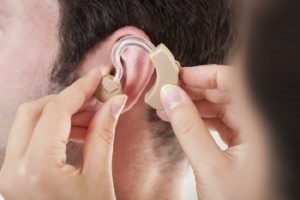
A behind-the-ear hearing aid has many different parts that enables it to work correctly.
Many of us know that a hearing aid is used to assist people with significant hearing loss. However, it is also important to know the parts of a hearing aid so that you know how it works if you ever need to invest in one. Here are the parts of the common behind-the-ear (BTE) hearing aid to give you a better understanding of how they are made and how they work.
Microphone And Amplifier
All hearing aids have a microphone that actually picks up on sounds and then sends it to the amplifier so a person can hear the sounds more clearly. In a BTE hearing aid, both the mic and the amplifier are in the case that fits on the outside of the ear. You want to keep your hearing aid clean and dry in order to keep the microphone working properly.
Ear Hook
Similar to glasses, the BTE hearing aid has a hook that goes around the outside of your ear. Also known as an elbow, this look connects the microphone and amplifier to the tubing and mold that goes inside the ear. This ear hook will eventually wear out and need replacing due to natural perspiration and body oils breaking down the plastic that it’s made of. You should wipe the ear hook daily with a soft cloth to increase its lifespan. You want the hook to fit snug, but not to the point where it’s uncomfortable.
Earmold
This is the part of the hearing aid that you see inside of a person’s ear canal. There are four common types of earmolds:
- Canal: These fit only in the ear canal and don’t extend into the concha bowl (the outer part of the ear closest to the canal)
- Full-Shell: This design is made to reduce feedback as much as possible and is for people with moderate to severe hearing loss.
- Skeleton: These are very similar to full-shell earmolds, except that they are designed with a cutout portion to make them more discreet.
- Half-Shell: These earmolds only cover the bottom of the concha bowl and are made for people with mild hearing loss.
Battery Compartment
The battery compartment in BTE hearing aids are typically located near the on/off switch that’s in the casing behind your ear. You should remove the batteries each night and leave the compartment open so that any moisture built up can evaporate. Hearing aid batteries typically last anywhere from 5 to 14 days so if you are having problems, it might be time for a new battery.
Contact Bay Area Audiology Today For Your Hearing Aid!
Ready to change the way you look at hearing loss? Our Doctor of Audiology, Dr. Trisha A. Bents Muth, is exceptionally experienced in the art of audiology, and is dedicated to providing the absolute best solutions. Bay Area Audiology has been working to give patients a comfortable environment, with thorough evaluations. We are independently owned, and unbiased when it comes to finding you the care you need.
You can always come into the office, or contact us in advance to set up an appointment. We also provide updates on our social media websites. You can check out our Facebook, Twitter,
Google+, LinkedIn, and Pinterest to keep up with Bay Area Audiology.
Don’t hesitate–we can help.
